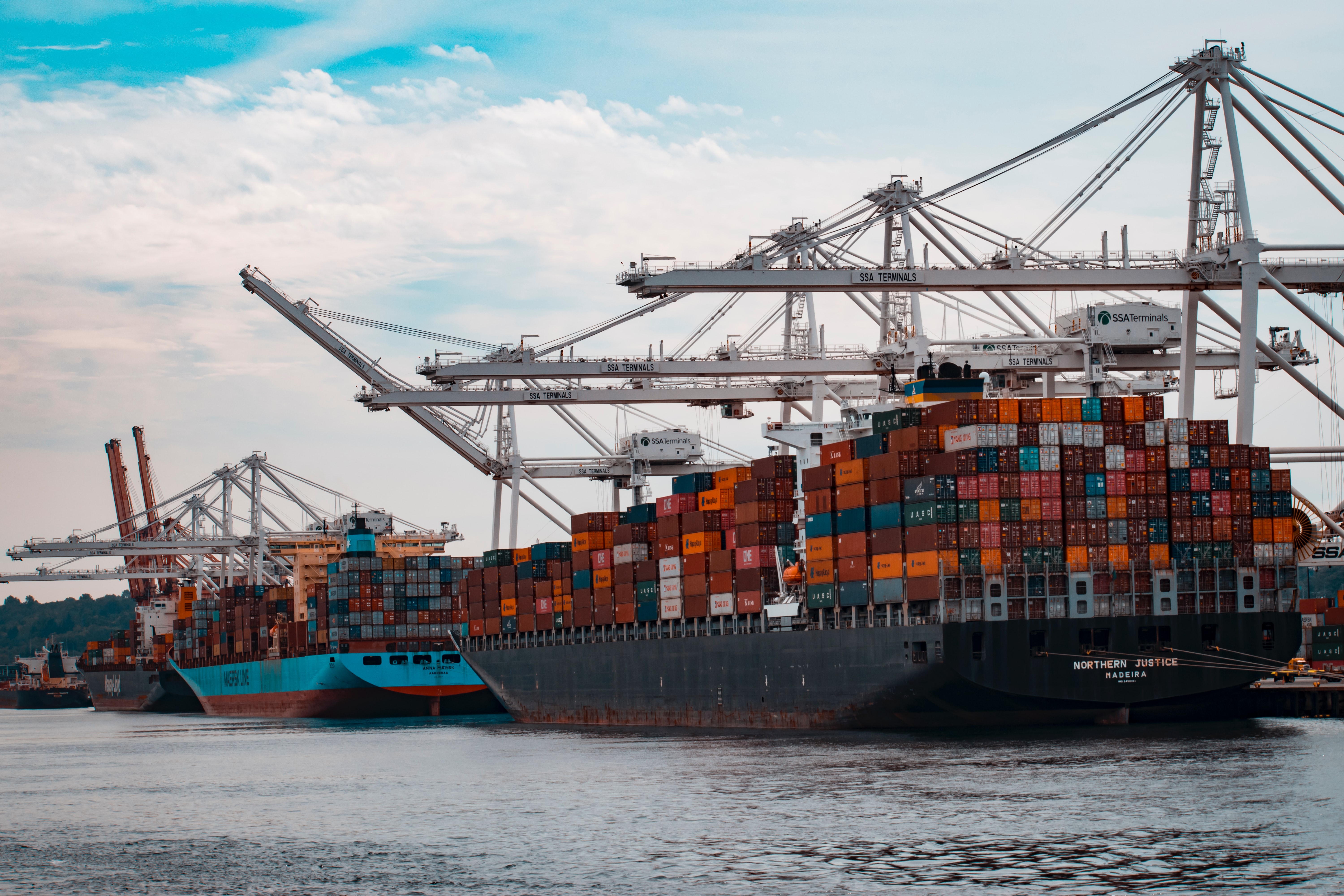
September 10, 2020 by Paul Hockenos
International freight transport — whether by air, land, or sea — still relies overwhelmingly on fossil fuels, accounting for 30 percent of transportation-related carbon dioxide emissions and more than 7 percent of all global emissions. Experts agree that freight, and international trade more broadly, must be decarbonized if we expect to hit the Paris Agreement’s climate goals. With the world’s freight carriers deeply shaken and supply chains upturned by the Covid-19 pandemic, now is exactly the right time to begin reshaping it.
Until recently, global trade has been largely ignored in the discourse about the transition to a low-carbon economy. One reason is that it is a cross-border business, and thus largely falls outside of the emissions reduction plans of individual nations. As a result, it has escaped much of the scrutiny that other industries have faced over their carbon footprints.
In the midst of the coronavirus crisis, with so many planes grounded, ports restricted, and borders sealed, the world has a rare opportunity to make sweeping changes in the freight sector. It should jump on the chance.
Many of the world’s largest freight transporters are flailing during the pandemic and will be reliant on government money to survive. Major European airlines are cutting massive bailout deals with their governments right now. (Over one fifth of aviation’s carbon footprint stems from freight transport.) Cargo shipping and road freight are also at crossroads. As a result, governments have leverage to prod these industries to go greener and contribute their fair share to hitting international climate targets.
This might, at first, sound like a Sisyphean task. Global trade is the source of millions of jobs and diverse, inexpensive goods for consumers around the world. But there is growing recognition of freight’s centrality in the climate crisis, and there have already been tentative moves to decarbonize it — by requiring sustainable biofuel blending and better energy efficiency, as well as by shifting emissions-heavy road freight to railroads and ships. For example, in 2018 the International Maritime Organization, the U.N. agency responsible for establishing environmental standards for the shipping industry, for the first time pledged to reduce greenhouse gas emissions from international shipping to half of 2008 levels by 2050. The EU’s $1.7 billion Connecting Europe Facility will, among many other projects, bolster the continent’s rail networks and facilitate the adoption of greener fuels for all modes of transportation in the E.U., including freight carriers.
There are several ways the trade sector can continue building on this foundation.
First, governments should attach environmental conditions to any pandemic-related bailouts and loans. “The case for reconsidering the current incentive structure of transport-related policies has never been stronger,” says Olaf Merk of the International Transport Forum at the Organization for Economic Cooperation and Development.
Austria and France are already doing this with their national airlines. In Austria, government-secured loans and grants totaling more than $500 million to Austrian Airlines come with stipulations that the airline limit short-haul flights and cut its carbon emissions to 50 percent of 2018 levels by 2030. Likewise, the French government has insisted that Air France, which will collect $8.3 billion in government aid and loans, slash emissions from domestic flights by 50 percent by 2024 and buy more fuel-efficient planes. In stark contrast, Germany required nothing of the sort from Lufthansa — which owns Austrian Airlines — in exchange for its $9.9 billion rescue package.
Strings should also be attached to rescue money and loans to cargo shippers, should more require them. International shipping carries close to 80 percent of global trade and accounts for 2.5 percent of global greenhouse gas emissions. French shipping company CMA CGM has already had to take a $1.1 billion loan, backed largely by the French government but with no conditions attached. Any future loans or bailouts should hinge on the condition that shipping companies reduce the carbon intensity of their transport by at least 40 percent by 2030 compared to 2018— a hard-nosed target that goes beyond the shipping sector’s current, non-binding pledge to reduce emissions to 50 percent of 2008 levels over the same time span. Though ambitious, the target is feasible: Ever more alternative fuels and electric and hybrid engine designs are emerging to replace the dirty maritime fuels used by most heavy-duty shippers.
“Shipping, most of which is freight, has largely escaped serious decarbonization measures until now,” says Carlos Calvo Ambel of the Brussels-based watchdog group Transport & Environment. “It has to set tough, binding targets.”
A second step that governments can take is to cut back global trade in favor of more regional production. Here, too, there is movement in Europe. French President Emmanuel Macron and German Chancellor Angela Merkel recently underscored the importance of diversifying supply chains to reduce dependence on foreign production and reinforce Europe’s “economic and industrial resilience and sovereignty.” As Björn Finke, E.U. correspondent for the German daily Süddeutsche Zeitung, wrote in May, the realization that so much of Europe’s medical supplies and technology come from China has prompted politicians to rethink the continent’s trade policy: “less globalization, less division of labor between countries, more at home.”
Another policy measure that could impact imports is a recently proposed E.U. carbon border adjustment levy, which beginning by 2023 would apply a charge on goods imported into the E.U. based on the emissions emitted during their production. The tax could force trade partners to enforce emissions reduction measures not just on traded goods but on freight carriers too.
Of course, another means to decarbonize global trade would be to impose a hefty carbon tax on all international freight, as well as on aviation fuels, which currently go completely untaxed in the E.U. The E.U. is planning to apply carbon pricing to the shipping industry and reduce free carbon emission allowances currently allotted to airlines under Europe’s current policy.
These measures, though, must be implemented in a way that produces real change. Experts anticipate that trade by freight will triple by 2050, which would seriously undermine the goals of the Paris Agreement at present emissions levels. With talk of “Green Deals” in the air in Europe and the U.S., now is the time to set the freight sector on the road to comprehensive decarbonization.
Paul Hockenos is a Berlin-based journalist and author of several books on European politics.
This article was originally published on Undark. Read the original article.


